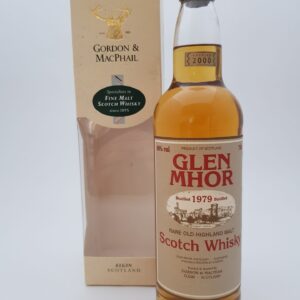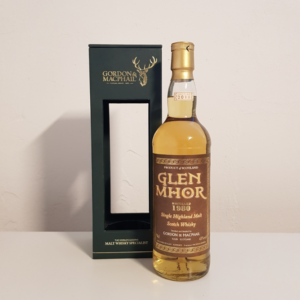Showing all 2 resultsSorted by popularity
Introduction to Glen Mhor
A distillery with a passion for craftsmanship
Glen Mhor was a historic Scottish Highlands distillery that embodied the essence of traditional Speyside whisky crafting. Located on the banks of the Caledonian Canal in Inverness, this now-silent distillery once produced some of Scotland’s most distinctive malts, prized by blenders and connoisseurs alike. Though no longer operational, its legacy continues to captivate whisky enthusiasts around the world.
The distillery’s strategic location in Inverness – the capital of the Highlands – gave it unique access to the pure waters of the River Ness, contributing to the distinguished character of its spirit.
Why we have a soft spot for Glen Mhor
At Vault of Spirits, we treasure distilleries that represent important chapters in Scotland’s rich whisky heritage. Glen Mhor holds a special place in our hearts for its historical significance and the increasingly rare expressions that occasionally emerge from remaining stocks.
Its distinctive character – a robust Highland style with subtle coastal influences – represents a flavor profile that has largely disappeared from today’s whisky landscape, making each surviving bottle a precious time capsule of Scottish distilling history.
The History behind Glen Mhor
Origin and development
Glen Mhor was established in 1892 by John Birnie, a former manager at neighboring Glen Albyn, and James Mackinlay of the Edinburgh blending house Charles Mackinlay & Co. The name “Glen Mhor” (pronounced “Glen Vor”) translates from Gaelic as “Great Glen,” referencing the legendary geographical feature that cuts across the Scottish Highlands.
Throughout the early 20th century, the distillery flourished under the stewardship of the founding families, surviving through both World Wars and the American Prohibition. In 1972, it was acquired by Distillers Company Limited (DCL), which would later become part of Diageo.
Unfortunately, like many traditional distilleries during the infamous “whisky loch” surplus of the 1980s, Glen Mhor fell victim to industry consolidation, closing its doors in 1983 and being demolished in 1986 to make way for a retail development.
The people behind
The partnership between John Birnie and the Mackinlay family created a strong foundation for Glen Mhor. Birnie’s technical expertise in distillation combined perfectly with the Mackinlays’ commercial acumen and blending heritage.
John Birnie remained as the distillery manager until his death in 1929, bringing an unwavering commitment to quality and consistency. His meticulous approach to whisky-making helped establish Glen Mhor’s reputation for excellence that endured throughout its operational life.
The Craft and Production
From raw material to finished product
Glen Mhor was known for its traditional production methods, including the use of locally sourced barley and the distinctive local water from the River Ness. The distillery utilized a unique combination of long fermentation times (often exceeding 60 hours) and slow distillation in its copper pot stills.
Most notably, Glen Mhor was one of the last Scottish distilleries to use a Saladin box for malting – a semi-mechanical floor malting system that allowed for more consistent results while retaining traditional techniques. This method contributed significantly to the distinctive character of the spirit.
The distillery’s stills had a distinctive shape with a wide spherical base and a sharply narrowing neck, which created a spirit with both weight and refinement – a signature of the Glen Mhor profile.
Maturation and aging
Glen Mhor’s spirit was primarily matured in American oak ex-bourbon casks and European oak sherry butts, stored in traditional dunnage warehouses with thick stone walls that maintained consistent cool temperatures.
The location near the Moray Firth is believed to have imparted subtle coastal influences during maturation, adding complexity to the otherwise robust Highland character. Especially in older expressions, this marriage of Highland strength and maritime complexity makes surviving Glen Mhor bottles highly prized by collectors and connoisseurs.
Selected Products from Glen Mhor
Independent Bottlings – Windows to a lost distillery
Since the distillery closed in 1983, expressions from Glen Mhor appear only through independent bottlers who acquired casks before the closure. These rare bottlings from companies like Gordon & MacPhail, Signatory Vintage, and Duncan Taylor provide the only opportunities to experience this lost whisky.
Typically, these expressions showcase the classic Glen Mhor profile of rich maltiness, subtle peat, orchard fruits, and a distinctive waxy mouthfeel that was characteristic of many traditional Highland distilleries of that era.
Rare Vintage Releases – A journey through time
The most sought-after Glen Mhor releases are those distilled in the 1960s and 1970s, just before the distillery’s closure. These whiskies often display remarkable depth, with complex notes of honey, beeswax, stone fruits, subtle maritime minerality, and delicate spices – sometimes with a hint of medicinal character that has become increasingly rare in modern Scotch whisky.
Each surviving bottle represents not just a drinking experience but a historical artifact from a bygone era of Scottish whisky production that can never be replicated.
Visiting the distillery
Historical sites
Although the distillery itself no longer exists, whisky enthusiasts visiting Inverness can still trace its footsteps. The site where Glen Mhor once stood is now occupied by a retail park, but historical markers in the area acknowledge its importance to Inverness’s industrial heritage.
The nearby Inverness Museum and Art Gallery occasionally features exhibits on the city’s whisky-making past, including references to Glen Mhor and its significance to the local economy throughout the 20th century.
Frequently Asked Questions
What was Glen Mhor?
Glen Mhor was a Highland Scotch whisky distillery located in Inverness, Scotland, operational from 1892 until 1983. It produced a distinctive style of single malt whisky prized for its robust character, subtle complexity, and slight maritime influence – characteristics that were widely sought after by blenders and independent bottlers.
Where was Glen Mhor located?
The distillery was situated in Inverness, the capital of the Scottish Highlands, specifically on the banks of the Caledonian Canal near its junction with the River Ness. This location provided not only the water source for production but also convenient transport links that facilitated distribution.
What characterized Glen Mhor whisky?
Glen Mhor was known for producing a robust Highland malt with a distinctive waxy character, notes of orchard fruits, subtle peat influence, and a complex maltiness. Older expressions often display honeyed sweetness, beeswax, and a hint of maritime character that developed during long maturation.
The distillery’s use of traditional production methods, including the Saladin box malting system and unique still shapes, contributed to creating a style of whisky that has largely disappeared from the contemporary Scotch landscape.
Where can I buy whisky from Glen Mhor?
As Glen Mhor has been closed for nearly four decades, bottles are increasingly rare and appear primarily through specialty retailers, auctions, and whisky collectors. At Vault of Spirits, we occasionally secure exceptional examples of this lost distillery’s work, offering whisky enthusiasts the opportunity to experience a truly historical dram.
We carefully authenticate each bottle to ensure its provenance, as these rare expressions represent not just exceptional whisky but important artifacts of Scotland’s distilling heritage.

